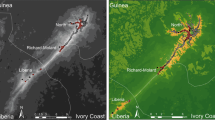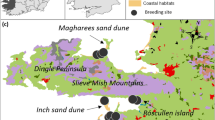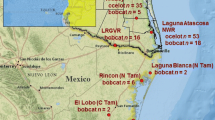Abstract
Landscape attributes often shape the spatial genetic structure of species. As the maintenance of genetic connectivity is increasingly a conservation priority, the identification of landscape features that influence connectivity can inform targeted management strategies. The northern quoll (Dasyurus hallucatus) is a carnivorous marsupial that has experienced dramatic population declines in recent decades. To inform management of surviving D. hallucatus populations across north-western Australia we examined the genetic structure of populations, and identified landscape features that influence gene flow within the Kimberley region. We sampled 249 individuals from 28 populations in three regions of north-western Australia, including the Kimberley, Pilbara and Kakadu. Genetic structuring was evident between the three regions and to a lesser extent between the north and central Kimberley. Landscape genetic analysis of Kimberley populations suggest this structuring may be due in part to the indirect effects of differences in rainfall between these two areas. Also, D. hallucatus populations with large areas of open habitat between them tended to be more genetically similar. Managing threats such as the occurrence of intense and frequent fires, and the density of introduced herbivores, could support the persistence of D. hallucatus populations, particularly in areas with high rainfall and flat terrain, where greater genetic connectivity confers a better chance of long-term population survival.





Similar content being viewed by others
References
Adamack AT, Gruber B (2014) PopGenReport: simplifying basic population genetic analyses in R. Methods Ecol Evol 5:384–387
Andersen AN et al (1998) Fire research for conservation management in tropical savannas: introducing the Kapalga fire experiment. Aust J Ecol 23:95–110. doi:10.1111/j.1442-9993.1998.tb00708.x
Archer M (1979) The status of Australian Dasyurids, Thylacinids and Myrmecobids. In: Tyler MJ (ed) The status of endangered Australasian wildlife. Royal Zoological Society of South Australia, Adelaide
Bates D, Maechler M, Bolker B, Walker S (2014) lme4: Linear mixed-effects models using Eigen and S4, R package version 1.1-7
Beirnacki C, Celeux G, Golaert G, Langrognet F (2006) Model-based cluster and discriminant analysis with the MIXMOD software. J Comput Stat Data Anal 51:587–600
Blair C, Arcos VHJ, de la Cruz FRM, Murphy RW (2013) Landscape genetics of leaf-toed geckos in the tropical dry forest of Northern Mexico. PLoS one 8:e57433
Bradley A, Kemper C, Kitchener D, Humphreys W, How R (1987) Small mammals of the Mitchell Plateau region, Kimberley, Western Australia. Wildl Res 14:397–413. doi:10.1071/WR9870397
Braithwaite R, Griffiths A (1994) Demographic variation and range contraction in the northern quoll, Dasyurus hallucatus (Marsupialia: Dasyuridae). Wildl Res 21:203–217. doi:10.1071/WR9940203
Braunisch V, Segelbacher G, Hirzel AH (2010) Modelling functional landscape connectivity from genetic population structure: a new spatially explicit approach. Mol Ecol 19:3664–3678
Bureau of Meteorology (2015) Climate data online. Commonwealth of Australia, Bureau of Meteorology. http://www.bom.gov.au/climate/data/?ref=ftr. Accessed 1 March 2014
Carwardine J, O’Connor T, Legge S, Mackey B, Possingham HP, Martin TG (2011) Priority threat management to protect Kimberley wildlife. CSIRO Ecosystem Sciences, Brisbane
Cook AC (2010) Habitat use and home range of the northern quoll, Dasyurus hallucatus: effects of fire. The University of Western Australia
Danley PD, DeCarvalho TN, Fergus DJ, Shaw KL (2007) Reproductive asynchrony and the divergence of hawaiian crickets. Ethology 113:1125–1132. doi:10.1111/j.1439-0310.2007.01430.x
Darriba D, Taboada GI, Doallo R, Posada D (2012) jModelTest2: more models, newheuristics and parallel computing. Nat Methods 9:772
Dlugosch K, Parker I (2008) Founding events in species invasions: genetic variation, adaptive evolution, and the role of multiple introductions. Mol Ecol 17:431–449
Dudaniec RY, Wilmer JW, Hanson JO, Warren M, Bell S, Rhodes JR (2016) Dealing with uncertainty in landscape genetic resistance models: a case of three co-occurring marsupials. Mol Ecol 25:470–486
Earl D, vonHoldt B (2012) STRUCTURE HARVESTER: a website and program for visualizing STRUCTURE output and implementing the Evanno method. Conserv Genet Res 4:359–361
Edwards LJ, Muller KE, Wolfinger RD, Qaqish BF, Schabenberger O (2008) An R statistic for fixed effects in the linear mixed model. Stat Med 27:6137–6157
EPBC (1999) Dasyurus hallucatus ed. 2007 Deparment of the Environment and Water Resources. Australian Government, Canberra
Epps CW, Wehausen JD, Bleich VC, Torres SG, Brashares JS (2007) Optimizing dispersal and corridor models using landscape genetics. J Appl Ecol 44:714–724
Evanno G, Regnaut S, Goudet J (2005) Detecting the number of clusters of individuals using the software structure: a simulation study Molecular. Evolution 14:2611–2620
Fisher R, Vigilante T, Yates C, Russell-Smith J (2003) Patterns of landscape fire and predicted vegetation response in the north Kimberley region of Western Australia. Int J Wildland Fire 12:369–379. doi:10.1071/wf03021
Fisher DO et al (2014) The current decline of tropical marsupials in Australia: is history repeating? Glob Ecol Biogeogr 23:181–190. doi:10.1111/geb.12088
Foll M, Gaggiotti O (2008) A genome-scan method to identify selected loci appropriate for both dominant and codominant markers: a Bayesian perspective. Genetics 180:977–993
Frank ASK et al (2014) Experimental evidence that feral cats cause local extirpation of small mammals in Australia’s tropical savannas. J Appl Ecol 51:1486–1493. doi:10.1111/1365-2664.12323
Frankham R (1995a) Conservation genetics. Annu Rev Genet 29:305–327
Frankham R (1995b) Inbreeding and extinction: a threshold effect. Conserv Biol 9:792–799
Funk WC, Blouin MS, Corn PS, Maxell BA, Pilliod DS, Amish S, Allendorf FW (2005) Population structure of Columbia spotted frogs (Rana luteiventris) is strongly affected by the landscape. Mol Ecol 14:483–496
Garrick R, Nason J, Meadows C, Dyer R (2009) Not just vicariance: phylogeography of a Sonoran Desert euphorb indicates a major role of range expansion along the Baja Peninsula. Mol Ecol 18:1916–1931
Geosciences Australia (2014) Data and Publications. http://www.ga.gov.au/data-pubs
Geosciences Australia (2015) GEODATA 9 Second DEM and D8 Flow Direction Grid 2008 Version 3.0. Commonwealth of Australia. http://www.ga.gov.au
Giordano AR, Ridenhour BJ, Storfer A (2007) The influence of altitude and topography on genetic structure in the long-toed salamander (Ambystoma macrodactulym). Mol Ecol 16:1625–1637. doi:10.1111/j.1365-294X.2006.03223.x
Gittleman JL, Funk SM, Macdonald DW, Wayne RK (2001) Carnivore conservation. Cambridge University Press, Cambridge
Goslee SC, Urban DL (2007) The ecodist package for dissimilarity-based analysis of ecological data. J Stat Softw 22:1–19
Guindon S, Gascuel O (2003) A simple, fast and accurate mothod to estimate large phylogenies by maximum likelihood. Syst Biol 52:696–704
Halekoh U, Højsgaard S (2014) A Kenward-Roger approximation and parametric bootstrap methods for tests of linear mixed models—the R package pbkrtest. J Stat Softw 59:1–30
Hill B, Ward S (2008) National recovery plan for the northern quoll Dasyurus hallucatus. Australian government deparment of the Environment and Water Resources, Canberra
How RA, Dell J, Cooper NK (1991) Vertebrate fauna of the Abydos-Woodstock Reserve, northeast Pilbara. Rec West Aust Mus 37:78–125
How RA, Spencer PBS, Schmitt LH (2009) Island populations have high conservation value for northern Australia’s top marsupial predator ahead of a threatening process. J Zool 278:206–217
Huelsenbeck JP, Ronquist F (2001) MRBAYES: Bayesian inference of phylogeny. Bioinformatics 17:754–755
Hutchison DW, Templeton AR (1999) Correlation of pairwise genetic and geographic distance measures: inferring the relative influences of gene flow and drift on the distribution of genetic variability. Evolution 53:1898–1914. doi:10.2307/2640449
Jombart T (2008) Adegenet: a R package for the multivariate analysis of genetic markers. Bioinformatics 24:1403–1405. doi:10.1093/bioinformatics/btn129
Jombart T, Devillard S, Dufour A, Pontier D (2008) Revealing cryptic spatial patterns in genetic variability by a new multivariate method. Heredity 101:92–103
Jost L (2008) Gst and its relatives do not measure differentiation Mol Ecol 17:4015–4026. doi:10.1111/j.1365-294X.2008.03887.x
Kitchener DJ (1978) Mammals of the Ord River area, Kimberley, Western Australia. Rec West Aust Mus 6:192–219
Kitchener DJ, Keller LE, Chapman A, McKenzie NL, Start AN, Kenneally KF (1981) Observations of mammals of the Mitchell Plateau and Admiralty Gulf, Western Australia, vol 4. Western Australian Museam, Perth
Lamont BB, He T, Enright NJ, Krauss SL, Miller BP (2003) Anthropogenic disturbance promotes hybridization between Banksia species by altering their biology. J Evol Biol 16:551–557. doi:10.1046/j.1420-9101.2003.00548.x
Landguth EL, Cushman SA, Murphy MA, Luikart G (2010) Relationships between migration rates and landscape resistance assessed using individual-based simulations. Mol Ecol Res 10:854–862. doi:10.1111/j.1755-0998.2010.02867.x
Leahy L, Legge SM, Tuft K, McGregor H, Barmuta L, Jones M, Johnson CN (2016) Amplified predation after fire suppresses rodent populations in Australia’s tropical savannas. Wildl Res 42:705–716
Legendre P (2014) lmodel2: Model II regression. https://cran.r-project.org/web/packages/lmodel2/index.html
Legge S, Kennedy MS, Lloyd R, Murphy SA, Fisher A (2011a) Rapid recovery of mammal fauna in the central Kimberley, northern Australia, following the removal of introduced herbivores. Aust Ecol 36:791–799. doi:10.1111/j.1442-9993.2010.02218.x
Legge S, Murphy SA, Kingswood R, Maher B, Swan D (2011b) EcoFire: restoring the biodiversity values of the Kimberley region by managing fire. Ecol Manag Restor 12:84–92
Litvaitis JA et al (2015) Bobcats (Lynx rufus) as a model organism to investigate the effects of roads on wide-ranging carnivores. Environ Manag 55:1366–1376. doi:10.1007/s00267-015-0468-2
McKenzie NL (1981) Mammals of the Phanerozoic south-west Kimberley, Western Australia: biogeography and recent changes. J Biogeogr 8:263–270
McKenzie NL et al (2007) Analysis of factors implicated in the recent decline of Australia’s mammal fauna. J Biogeogr 34:597–611. doi:10.1111/j.1365-2699.2006.01639.x
McRae BH, Dickson BG, Keitt TH, Shah VB (2008) Using circuit theory to model connectivity in ecology, evolution and conservation. Ecology 89:2712–2724
Meirmans PG, Hedrick PW (2011) Assessing population structure: FST and related measures. Mol Ecol Resour 11:5–18
Meirmans PG, Van Tienderen PH (2004) GENOTYPE and GENODIVE: two programs for the analysis of genetic diversity of asexual organisms. Mol Ecol Notes 4:792–794
Moran PAP (1948) The interpretation of statistical maps. J R Stat Soc B 10:243–251
Moritz C (1994) Defining evolutionarily significant units for conservation. Trends Ecol Evol 9:373–375. doi:10.1016/0169-5347(94)90057-4
Narum S (2006) Beyond Bonferroni: less conservative analyses for conservation genetics. Conserv Genet 7:783–787. doi:10.1007/s10592-005-9056-y
Neel MC (2008) Patch connectivity and genetic diversity conservation in the federally endangered and narrowly endemic plant species Astragalus albens (Fabaceae). Biol Conserv 141:938–955
Oakwood M (2000) Reproduction and deomgraphy of the northern quoll, Dasyurus hallucatus, in the lowland savanna of northern Australia Australian. J Zool 48:519–539
Oakwood M (2002) Spatial and social organization of a carnivorous marsupial Dasyurus hallucatus (Marsupialia: Dasyuridae). J Zool 257:237–248. doi:10.1017/s0952836902000833
O’Donnell S, Webb JK, Shine R (2010) Conditioned taste aversion enhances the survival of an endangered predator imperilled by a toxic invader. J Appl Ecol 47:558–565. doi:10.1111/j.1365-2664.2010.01802.x
Pérez-Espona S, Pérez-Barbería F, McLeod J, Jiggins C, Gordon I, Pemberton J (2008) Landscape features affect gene flow of Scottish Highland red deer (Cervus elaphus). Mol Ecol 17:981–996
Phillips BL, Chipperfield JD, Kearney MR (2008) The toad ahead: challenges of modelling the range and spread of an invasive species. Wildl Res 35:222–234. doi:10.1071/WR07101
Pritchard J, Stephens M, Donnelly P (2000) Inference of population structure using multilocus genotype data. Genetics 155:945–959
Manel S, Schwartz MK, Luikart G, Taberlet P (2003) Landscape genetics: combining landscape ecology and population genetics. Trends Ecol Evol 18:189–197
R Development Core Team (2005) R (version 3.03). R Foundation for Statistical Computing, Vienna, Austria
Radford IJ et al (2014) Mammals of Australia’s tropical savannas: a conceptual model of assemblage structure and regulatory factors in the Kimberley region. PLoS One 9:e92341
Rambaut A (2007a) Fig tree. http://tree.bio.ed.ac.uk/software/figtree/
Rambaut A, Suchard MM, Xile D, Drummond AJ (2007b) Tracer v1.5. http://tree.bio.ed.ac.uk/software/tracer/
Rankmore BR, Griffiths AD, Woinarski JCZ, Ganambarr BL, Taylor R, Firestone K, Cardoso M (2008) Island traslocation of the northern quoll Dasyurus hallucatus as a conservation response to the spread of the cane toad Chaunus (Bufo) marinus in the Northern Territory, Australia
Raymond M, Rousset F (1995) Genepop (Version-1.2)—population genetics software for exact tests and ecumenicism. J Hered 86:248–249
Riley SJ, DeGloria SD, Elliot R (1999) A terrain ruggedness index that qualifies topographic heterogeneity. Intermt J Sci 1999:23–27
Schwalm D, Waits L, Ballard W (2014) Little fox on the prairie: genetic structure and diversity throughout the distribution of a grassland carnivore in the United States. Conserv Genet 15:1503–1514. doi:10.1007/s10592-014-0634-8
Sergio F et al (2008) Top predators as conservation tools: ecological rationale, assumptions, and efficacy. Annu Rev Ecol Evol Syst 39:1–19. doi:10.2307/30245151
Seutin G, White BN, Boag PT (1991) Preservation of avian blood and tissue samples for DNA analysis. Can J Zool 69:82–90
Simcharoen S, Barlow ACD, Simcharoen A, Smith JLD (2008) Home range size and daytime habitat selection of leopards in Huai Kha Khaeng Wildlife Sanctuary, Thailand. Biol Conserv 141:2242–2250. doi:10.1016/j.biocon.2008.06.015
Smith AL, Friesen VL (2007) Differentiation of sympatric populations of the band-rumped storm-petrel in the Galapagos Islands: an examination of genetics, morphology, and vocalizations. Mol Ecol 16:1593–1603. doi:10.1111/j.1365-294X.2006.03154.x
Spencer PBS, Cardoso M, How RA, Williams J, Bunce M, Schmitt LH (2007) Cross-species amplification at microsatellite loci in Australian quolls including the description of five new markers from the Chuditch (Dasyurus geoffroii). Mol Ecol Notes 7:1100–1103. doi:10.1111/j.1471-8286.2007.01791.x
Storfer A et al (2007) Putting the landscape in landscape genetics. Heredity 98:128–142
Thomassen HA, Freedman AH, Brown DM, Buermann W, Jacobs DK (2013) Regional differences in seasonal timing of rainfall discriminate between genetically distinct East African giraffe taxa. PLoS ONE 8:e77191
Van Oosterhout C, Hutchinson B, Wills D, Shipley P (2004) MICRO-CHECKER: software for identifying and correcting genotyping errors in microsatellite data. Mol Ecol Notes 4:535–538
Van Strien MJ, Keller D, Holderegger R (2012) A new analytical approach to landscape genetic modelling: least cost transect analysis and linear mixed models. Mol Ecol 21:4010–4023
Vigilante T (2001) Analysis of explorers’ records of aboriginal landscape burning in the Kimberley region of Western Australia. Aust Geogr Stud 39:135–155. doi:10.1111/1467-8470.00136
Vigilante T, Bowman D, Fisher R, Russell-Smith J, Yates C (2004) Contemporary landscape burning patterns in the far north Kimberley region of north-west Australia: human influences and environmental determinants. J Biogeogr 31:1317–1333. doi:10.1111/j.1365-2699.2004.01104.x
Wasserman T, Cushman S, Schwartz M, Wallin D (2010) Spatial scaling and multi-model inference in landscape genetics: Martes americana in northern Idaho. Landsc Ecol 25:1601–1612. doi:10.1007/s10980-010-9525-7
Wikramanayake E, McKnight M, Dinerstein E, Joshi A, Gurung B, Smith D (2004) Designing a conservation landscape for tigers in human-dominated environments. Conserv Biol 18:839–844. doi:10.2307/3589094
Woinarski J, Burbidge A, Harrison P (2014) The action plan for Australian mammals 2012. CSIRO Publishing, Collingwood
Woinarski JCZ et al (2011) The disappearing mammal fauna of northern Australia: context, cause, and response. Conserv Lett 4:192–201. doi:10.1111/j.1755-263X.2011.00164.x
Woinarski JCZ et al (2008) Surviving the toads: patterns of persistence of the northern quoll Dasyurus hallucatus in Queensland. The Australian Government’s Natural Heritage Trust
Woolley PA, Krajewski C, Westerman M (2015) Phylogenetic relationships within Dasyurus (Dasyuromorphia: Dasyuridae): quoll systematics based on molecular evidence and male characteristics. J Mammal 96:37–46
Yamamoto S, Beljaev EA, Sota T (2016) Phylogenetic analysis of the winter geometrid genus Inurois reveals repeated reproductive season shifts. Mol Phylogenet Evol 94:47–54. doi:10.1016/j.ympev.2015.08.016
Ziembicki MR, Woinarski JC, Mackey BG (2013) Evaluating the status of species using indigenous knowledge: novel evidence for major native mammal declines in northern Australia. Biol Conserv 157:78–92
Acknowledgments
This study was funded by supporters of the Australian Wildlife Conservancy, an Australian Research Council Linkage Grant (100100033), and the Department of Parks and Wildlife (Western Australia). The study methods were approved by the University of Tasmania Animal Ethics Committee (permit number A12516). This project would not have been possible without the support of staff at Australian Wildlife Conservancy’s Mornington Wildlife Sanctuary. Terry Webb also gave tremendous assistance sourcing and processing GIS layers. Also, thankyou to Alex Hartshorne, Hannah Cliff, Jillian Smith, Joel Murray, David James, Peter Richardson, Kaely Kreger, Davina Bright, Tom Crawford and Iris Bleach for their help with fieldwork.
Author information
Authors and Affiliations
Corresponding author
Electronic supplementary material
Below is the link to the electronic supplementary material.
Rights and permissions
About this article
Cite this article
Hohnen, R., D. Tuft, K., Legge, S. et al. Rainfall and topography predict gene flow among populations of the declining northern quoll (Dasyurus hallucatus). Conserv Genet 17, 1213–1228 (2016). https://doi.org/10.1007/s10592-016-0856-z
Received:
Accepted:
Published:
Issue Date:
DOI: https://doi.org/10.1007/s10592-016-0856-z




